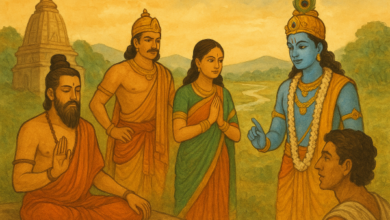Musical beauty of Ankiya Bhaona
Sankardeva created Ankiya Bhaona on Assamese folk traditions

 Music is an energetic expression of the mind. Music creation is not the result of any process but a spontaneous thought. Then what is the foundation of its creation? Emotive thought blended with reality creates music. Music and instruments are real, concept is abstract. Once in a live show in the US, an African singer said that Africans were singing with the cutting sounds of wood in jungles. The conversation of the Africans in sorrow, joy or excitement unknowingly resulted in songs mingling with cutting sounds.
Music is an energetic expression of the mind. Music creation is not the result of any process but a spontaneous thought. Then what is the foundation of its creation? Emotive thought blended with reality creates music. Music and instruments are real, concept is abstract. Once in a live show in the US, an African singer said that Africans were singing with the cutting sounds of wood in jungles. The conversation of the Africans in sorrow, joy or excitement unknowingly resulted in songs mingling with cutting sounds.
The classification of music means mode. Mode emanates from the various synchronisation stages of the said conversation with sound. Music is an impulse of the mind and has seven modes in the West. These modes have similar counterparts in other regions. The seven western modes are lonian (Bilawal), Dorian (Kafi), Phrygian (Bhairavi), Lydian (Yaman), Mixolydian (Khamaj), Aeolian (Ashowari) and Locrian (Todi).
BORGEET:
Srimanta Sankardeva developed a new classical form of music called Borgeet (‘Bor’ means great and ‘geet’ means song). The name of the music is Sankari or Satriya. The two names have disputes. The followers of Satra claim it as Satriya and mostly Namghar-centric. The Mahapurushiya call it Sankari. Indeed, all the satras do not remain as Sankari organisation because of the Brahmanical influence.
The Borgeet is the musical foundation of Sankari culture. Sankardeva did fusions of two/three ragas together for some specific characters of Bhaona. It is not known how many ragas or talas he created. He wrote 240 Borgeets which were destroyed in a fire. Sankardeva recovered only 34 Borgeets from memory. Later, he stopped writing.
Three varieties of classical music were created — Hindustani of North India, Carnatic of South India and Sankari of North East India. The Hindustani music was influenced by Arabic-Indian music. Within the Indian Dhrupad style, a new Persian genre emerged. The Muslim monarchs patronised the Indian music and resulted in minimising Hindu religious and spiritual themes. The king of Hindustani classical music, Ramtanu Pandey aka Tansen (1500–1589), was a musician at the Mughal court under emperor Akbar. He joined the Mughal court almost after the period of Sankardeva in 1562. The grammatical development of Hindustani music started with Tansen. So, Sankardeva got nothing from his genre.
The Sankari music was created among the ethnic tribes of Assam. The Borgeet existed before Sankardeva but in an unorganized form. The ‘Raga’ and ‘Tala’ of Borgeet are indebted to the ethnic communities of Assam.
Besides the romantic ‘Bonoriya Geet’’ and jovial agrarian songs before Bihu, many other religious or solemn songs were also prevalent in Assam. The ‘Charyapada’ of Buddhism is one of the ancient Assamese lyrics written in the seventh century.
Sankardeva also created Ankiya Bhaona on Assamese folk traditions. So, it is natural that Sankaradeva was inspired by the pre-existing folk songs and composed Borgeets and Ankiya songs.
The Assamese Ojapali ritual dates back to before Sankaradeva; for he made the essence of his verses known to people through the Ojapali ritual at the beginning of his preaching. There seems to be a reason to think that the Beula song of Durgabar was composed before Sankardeva.
Poet Durgabar also translated the Ramayana into songs. Writing a book in the form of a song was a common custom in those days. There was a poet named Pitambar in the Bhati region of old Kamrupa who recited poetry in the form of songs.
Songs Of Bhaona
The prime creation of Sankardeva is Ankiya Bhaona. The dialogue of the Ankiya is mostly lyrical and the drama has song and dance. An Ankiya Bhaona even can be performed by the play of songs only without any dialogue. So, songs occupy a major portion of a drama.
The most special character of Bhaona is Sutradhara. He is the interlocutor of the entire drama. The ‘Suhai Ektal’ is set for the Sutradhara. The meaning of bhatima is worship or glorification. There are different kinds of bhatima mentioned below:
(1) Naat (Drama) Bhatima
(2) Raj Bhatima (Panegyric to king)
(3) Guru Bhatima (Panegyric to teacher)
(4) Deva Bhatima (Panegyric to God)
There are different types of Ojapali performed in Kamrup and Barpeta districts. The two easily noticeable streams of Hinduism, Sakta and Vaishnava, are evident in all aspects of practice.
The epic-based Ojapali is a product of Vaishnava environmental art. The non-epic Ojapali was moulded in Sakta environmental art. While Vyasa Ojapali (Epic-based) sings hymns from the Ramayana, Mahabharata, Puranas and Sukanani Ojapali (non-epic) is associated with Sakta deity worship like Manasha Devi with hymns from the Padma Purana.
The streams and genres of music cannot be demarcated or separated properly. The Sankari music does not remain in the original mode for more than 500 years. Likewise, the Hindustani or Assamese tribal traditional music also has been changing. So, a complete and genuine verification is not possible. The writings are based on present observation and input.





